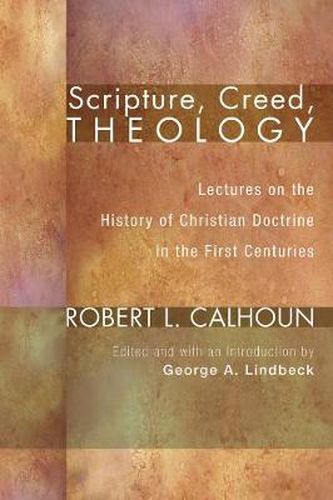Readings Newsletter
Become a Readings Member to make your shopping experience even easier.
Sign in or sign up for free!
You’re not far away from qualifying for FREE standard shipping within Australia
You’ve qualified for FREE standard shipping within Australia
The cart is loading…






This title is printed to order. This book may have been self-published. If so, we cannot guarantee the quality of the content. In the main most books will have gone through the editing process however some may not. We therefore suggest that you be aware of this before ordering this book. If in doubt check either the author or publisher’s details as we are unable to accept any returns unless they are faulty. Please contact us if you have any questions.
In this long-awaited edition of the late Robert Lowry Calhoun’s lectures on the history of Christian doctrine, a powerful case is made for the scriptural basis of the ancient ecumenical creeds. The way Calhoun reads the patristic authors helps us see that the Trinitarian three-yet-one and Christological two-yet-one creedal formulations provide patterns for sorting out the highly diverse biblical ways of speaking of God and of the Messiah (Jesus) so that they are not contradictory. The implied lesson (all the more effective for many of Calhoun’s students, just because he let them draw this conclusion by themselves) is that the creeds are not to be understood as deductions from scripture (which they are not in any straightforward way) but as templates for interpreting scripture. It is Trinitarian and Christological patterns of reading–which are implicitly operative for vast multitudes even in churches that profess to be creedless–that make it possible to treat the entire bible, Old and New Testaments together, as a unified and coherently authoritative whole.
$9.00 standard shipping within Australia
FREE standard shipping within Australia for orders over $100.00
Express & International shipping calculated at checkout
This title is printed to order. This book may have been self-published. If so, we cannot guarantee the quality of the content. In the main most books will have gone through the editing process however some may not. We therefore suggest that you be aware of this before ordering this book. If in doubt check either the author or publisher’s details as we are unable to accept any returns unless they are faulty. Please contact us if you have any questions.
In this long-awaited edition of the late Robert Lowry Calhoun’s lectures on the history of Christian doctrine, a powerful case is made for the scriptural basis of the ancient ecumenical creeds. The way Calhoun reads the patristic authors helps us see that the Trinitarian three-yet-one and Christological two-yet-one creedal formulations provide patterns for sorting out the highly diverse biblical ways of speaking of God and of the Messiah (Jesus) so that they are not contradictory. The implied lesson (all the more effective for many of Calhoun’s students, just because he let them draw this conclusion by themselves) is that the creeds are not to be understood as deductions from scripture (which they are not in any straightforward way) but as templates for interpreting scripture. It is Trinitarian and Christological patterns of reading–which are implicitly operative for vast multitudes even in churches that profess to be creedless–that make it possible to treat the entire bible, Old and New Testaments together, as a unified and coherently authoritative whole.